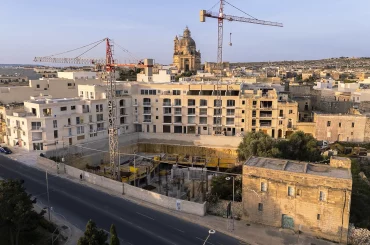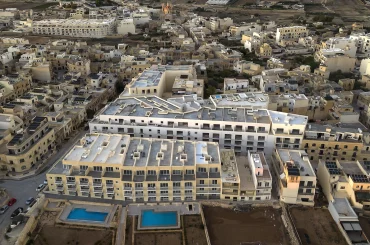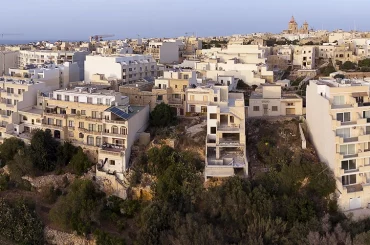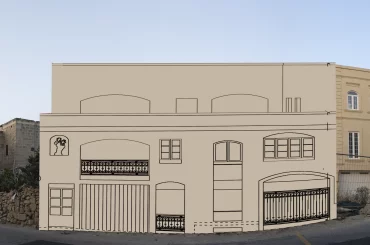The Planning Authority has said that its “investigations” have found that recent works at the cliffside near Ta Cenc at Ta Sannat is the “reinstatement” of corbelled huts, “some of which have been in existence prior to 1978, and therefore, considered as legally established.”
The works have taken place on land protected on two levels – as a Natura 2000 site and a Special Area of Conservation – where the cliff holds the second largest colony of nesting scopoli’s shearwaters in the Maltese Islands.
The Planning Authority’s replies confirm what was reported by this website last February – that six round structures are shaping up into corbelled huts – and additionally imply that these corbelled huts, already half-built, could be granted development permit under provisions of the rural policy which permits restoration of pre-1978 structures. The Planning Authority itself raised this prospect in its replies, saying that investigations are ongoing and it has yet “to ascertain whether any of these structures need to be dismantled and/or regularised”.
Investigations by this website found no evidence and no indication that corbelled huts (girna or plural giren in Maltese) ever existed in the area. No structures are shown in survey sheets dating to 1968, and, by 1998, aerial photography clearly shows four trapping sites. An aerial picture taken a few years ago – published below – shows that the trapping sites had faded and the hides, and small room, lay ruined.


The corbelled huts, possibly still half-built, have now arisen from the ruins of the trapping hides (see above).
Historical studies also show that there were no such cluster of 5 or 6 corbelled huts in that location. In a book published in 1998 – titled The Girna: the Maltese corbelled stone hut – the author Michael Fsadni wrote that in Gozo there were “always none [corbelled huts] at all”, and as such excluded Gozo from his study.
Godwin Vella, who works for Heritage Malta and studied corbelled huts (girna or giren in Maltese) in Gozo more extensively, wrote in a report in 2014 that Gozo has a “lesser concentration” of corbelled huts than Malta due to the prevalent geologic features. He explained that corbelled huts are located mostly in places where the geology is dominated by upper coralline limestone, with most corbelled huts found in the “Upper Coralline uplands of Xagħra, Nadur and Qala.” He published a geologic map of Gozo that shows that the location in Sannat is a globigerina limestone plateau – as such, not the kind of terrain where corbelled huts were usually built.

This website also spoke to photographer Daniel Cilia who has photographed many corbelled huts and originally hails from Gozo. Cilia, who is in his late fifties, said he has been familiar with the area since he was young.
“I used to go walking there with the boy scouts and we used to have someone talk to us about these heritage features. I never remember corbelled huts there – only hunting hides were there,” he said.
He added: “I have photographed many corbelled huts and I can say that the way they are building them at that location do not resemble corbelled huts.”
Rubble walls and PVC pipes
Construction of the corbelled huts is part of a range of works over an area stretching 350 metres from the fringes of Sannat’s built-up area to the cliff’s edge. The area, which amounts around 3 football pitches in size, is owned by Excel Investments Limited, a company owned by Joseph Portelli (majority shareholder), the Agius brothers (Ta Dirjanu), and Daniel Refalo.

At one end of the strip of land, Excel is developing a cluster of blocks of flats. Permit for three blocks, amounting to 124 flats, has already been granted, and a fourth application for an additional block of 24 flats is currently being processed.
On the land stretching between these flats and the cliff, an application for 4 stables is currently being processed by the Planning Authority. Other works carried out last September included rebuilding rubble walls and embedding PVC large-diameter pipes in the walls, as well as extending a dirt road to the cliffs edge, and depositing and spreading soil and rubble on garigue at the Special Area of Conservation.
The Planning Authority’s spokesperson told this website that the dirt road is of a “temporary nature”, and that land “needs to be reinstated.”

The spokesperson also said that the PVC pipes embedded in the wall are “not deemed acceptable, and need to be removed.”
So far the PVC pipes have been cut down to wall’s level and many of them superficially concealed by flat stones placed on top of them.
As for the rubble wall, the Planning Authority’s spokesperson said that the “construction, alteration, or maintenance of random dry-stone rubble walls” is permissible, and the works on the rubble wall are “in line with” provisions of the law that governs planning permitting for rubble walls.
Yet the regulation cited by the Planning Authority spokesperson specifies that “the total demolition and reconstruction of existing random dry-stone rubble walls (sejjiegħ) is not permitted.”
And some photographic evidence and sources among residents suggests that large sections of the rubble wall were dismantled and built again. The rubble walls that appeared last autumn are double the height of what existed before, and the superficial weathering of the stones in large sections also suggest it was rebuilt. So does the fact that, in some sections, the PVC pipes are embedded deep towards the bottom of the wall.

The Planning Authority’s spokesperson said that investigations are ongoing, and “consultations are underway in order to establish whether further (environmental) studies or assessments were/are required in relation to this development [rubble walls].”
He also said that an order to cease work remains in force until the “Authority concludes the investigations”, and that “the site is being monitored to ensure compliance with instructions.”




